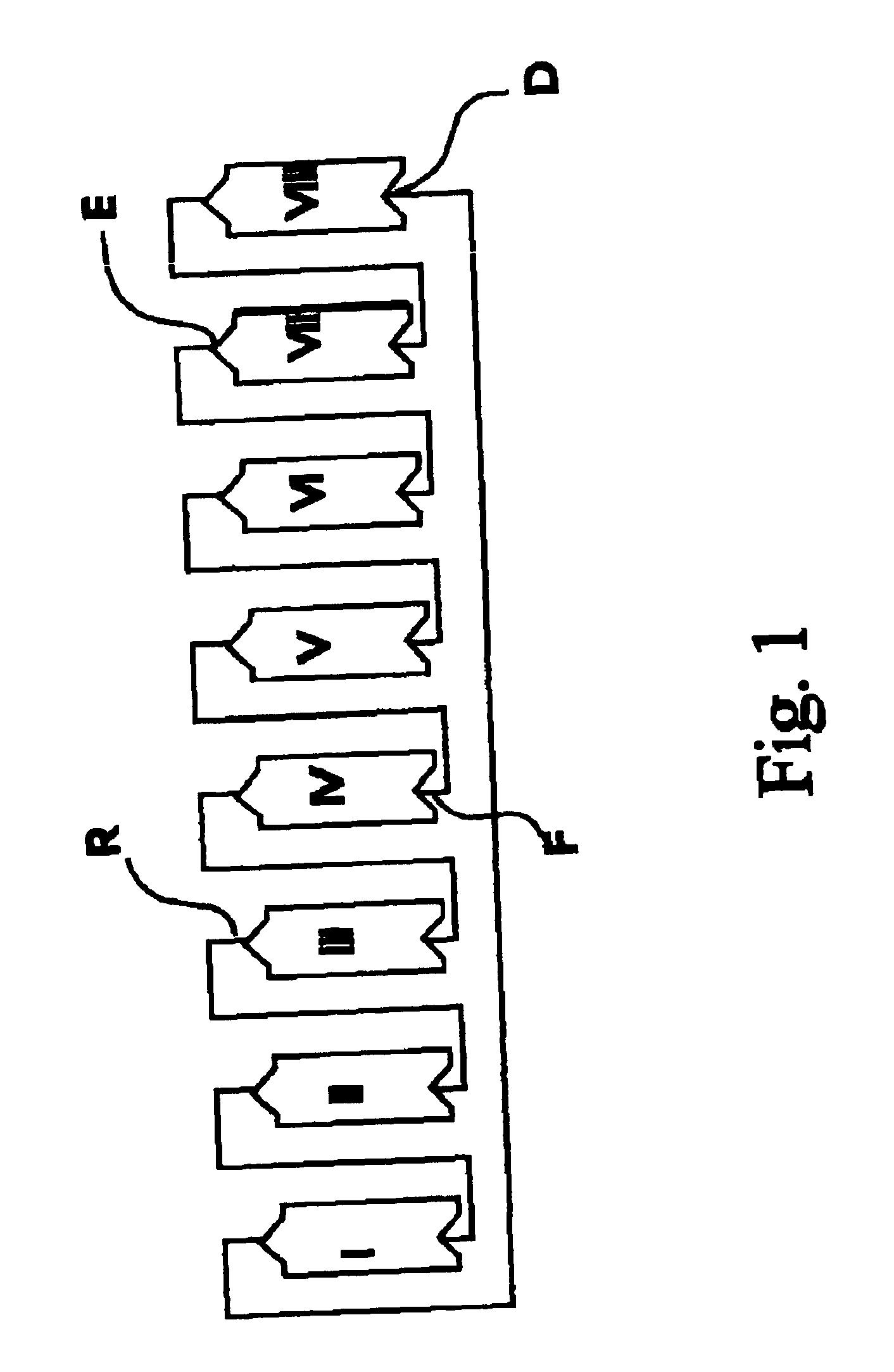Simulated moving bed chromatographic focusing
a chromatographic focusing and moving bed technology, applied in the direction of chemistry apparatus and processes, separation processes, ion exchangers, etc., can solve the problems of limited length of chromatographic columns, batch-type chromatography takes longer time for separating a defined quantity of products, and low sample loading
- Summary
- Abstract
- Description
- Claims
- Application Information
AI Technical Summary
Benefits of technology
Problems solved by technology
Method used
Image
Examples
example 2
Moving Bed Chromatographic Focusing of Pig Serum. The simulated moving bed chromatographic focusing system is assembled as described for the embodiment of FIG. 5 and contains an F section of 5 zones, a R section of 1 zone, a B section of 1 zone, and a S section of 1 zone. Each zone has a column (30 mm.times.4.6 mm; L.times.ID) packed with DEAE-Sepharose resin (50 .mu.m, from Pharmacia). The system is operated as described for the embodiment of FIG. 5 with column relocation every 1.5 min. Pig serum was the sample and was treated in the same way as in example 1. The composition and the flow rate of the fluids in the 8 zones are listed in Table 1. The system was operated for 40 column relocations. All the flow out fluids from zone S(1) and F(1) and 0.025 ml of the fluids from zone F(2), F(3), F(4), and F(5) were collected for each column relocation. The fractions corresponding to the 10.sup.th, 20.sup.th, 30.sup.th, and 40.sup.th column relocations were analyzed on a 10% non-denaturing...
example 3
Moving Bed Chromatographic Focusing of Pig Serum with fluid withdrawal by fluid displacement. The simulated moving bed chromatographic focusing system is assembled as described for the embodiment of FIG. 5. The separation was carried out the same as described in example 2 except that the fluid withdrawal from zone F(3) was done every 5 column relocations by fluid displacement described in the embodiment of FIG. 8. The displacement fluid was 0.05 ml of 0.17 M NaCl for each withdrawal. Other fluid withdrawals were the same as in example 2. The fractions corresponding to the 10.sup.th, 20.sup.th, 30.sup.th, and 40.sup.th column relocation were analyzed on a 10% non-denaturing polyacrylatide gel in the Laemmli buffer system. Compared to example 2, Compound B had more intense band in the fraction from zone F(3) and appeared purer.
example 4
Moving Bed Chromatographic Focusing of Pig Serum by the embodiment in FIG. 2b. The simulated moving bed chromatographic focusing system contains an F section of 6 zones and is assembled as described for FIG. 2b. Each zone has a column (30 mm.times.4.6 mm; L.times.ID) packed with DEAE-Sepharose resin (50 .mu.m, from Pharmacia). The system is operated as described for the embodiment of FIG. 2b with column relocation every 1.5 min. Pig serum was the sample and was treated in the same way as in example 1. The compositions and the flow rates of the introduced fluids in the 6 zones are listed in Table 2. The system was operated for 40 column relocations. All the flow out fluid from zone F1 and 0.03 ml of the fluids from zone F(2), F(3), F(4), F(5) and F(6) were collected for each column relocation. The fractions corresponding to the 10.sup.th, 20.sup.th, 30.sup.th, and .sub.40.sup.th column relocation were analyzed on a 10% non-denaturing polyacrylamide gel in the Laemmli buffer system. M...
PUM
 Login to View More
Login to View More Abstract
Description
Claims
Application Information
 Login to View More
Login to View More - R&D
- Intellectual Property
- Life Sciences
- Materials
- Tech Scout
- Unparalleled Data Quality
- Higher Quality Content
- 60% Fewer Hallucinations
Browse by: Latest US Patents, China's latest patents, Technical Efficacy Thesaurus, Application Domain, Technology Topic, Popular Technical Reports.
© 2025 PatSnap. All rights reserved.Legal|Privacy policy|Modern Slavery Act Transparency Statement|Sitemap|About US| Contact US: help@patsnap.com



